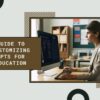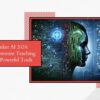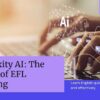Edutainment: The Future of Learning for K–12 Students
Introduction
In recent years, the term edutainment has been steadily gaining traction in educational circles, emerging as a revolutionary approach that combines education and entertainment to foster a more engaging learning environment. But what exactly is educational entertainment, and why is it becoming a cornerstone of modern education, especially for K–12 students?
Edu-tainment goes beyond the traditional methods of instruction, inviting a fresh perspective that encourages parent involvement, not just as spectators but as active participants in the learning journey. It opens up a realm of opportunities, offering a rich repository of homeschooling resources that are both informative and fun, transforming the way we perceive education.

As we delve deeper into this concept, we will explore the intricate fabric of instructional entertainment, unraveling its potential in instructional design and classroom management. From teachers navigating the dynamic landscape of education to parents seeking effective homeschooling resources, educational entertainment stands as a beacon of innovation, promising a learning experience that is both enriching and enjoyable.
Join us as we embark on this enlightening journey, unraveling the essence of edutainment and its pivotal role in shaping the future of education.
Understanding Learning through play
In the evolving landscape of education, edutainment stands as a concept that marries the joy of entertainment with the seriousness of learning. But to truly appreciate its value, we must first delve into its roots and understand its underlying principles.
The Concept of Edutainment
The term “edutainment” is more than just a buzzword; it represents a paradigm shift in instructional design, aiming to make learning a delightful experience. Its history is as rich as it is diverse, with its origins tracing back to a time when educators first recognized the potential of integrating entertainment into learning modules (ELM Learning).
But what sets edutainment apart is its ability to foster a dynamic and interactive learning environment, encouraging students to engage actively with the content. It’s not just about fun and games; it’s about leveraging entertainment to facilitate deeper understanding and retention.

The Pillars of Edutainment
As we delve deeper, we find that learning through play rests on solid foundations of educational theories and principles. It plays a pivotal role in classroom management, helping teachers create a learning space that is both engaging and effective.
Moreover, technology emerges as a significant player in the edutainment arena, offering a plethora of tools and platforms that enhance the learning experience. From interactive apps to virtual reality setups, informative amusement leverages the latest tech advancements to bring learning to life.
The Multifaceted Benefits of Educational Entertainment
In this section, we delve into the heart of educational entertainment, exploring the myriad benefits it offers to both students and the guiding figures in their lives—the teachers and parents. Let’s unravel how this approach can be a game-changer in the educational landscape.
For Students
This innovative approach has reshaped the learning landscape, offering students a vibrant and interactive platform where learning meets fun. Let’s explore how it enhances student engagement and fosters academic success.
Enhancing Learning Engagement
Through this method, students find themselves immersed in a learning environment that is both fun and educational, fostering a deeper connection with the subject matter. It encourages a love for learning, nurturing curiosity, and a keen sense of discovery (Monica Todiros Bușea on LinkedIn).
Boosting Academic Achievements
Research shows that this form of learning can significantly enhance academic achievements, helping students grasp complex concepts with ease and retain information more effectively (ResearchGate).
For Teachers and Parents
This learning-through-play strategy is not just a boon for students; it also offers a fresh perspective on teaching for educators and a rich resource pool for parents involved in homeschooling.
Facilitating Teaching Processes
Teachers find that incorporating fun into education aids in classroom management by offering interactive and engaging methods to present information, thus making the teaching process more enjoyable and effective.
Encouraging Active Participation from Students
For parents, this knowledge-based recreation serves as a rich repository of homeschooling resources, encouraging children to take an active role in their learning journey and fostering a collaborative and enriching learning environment.
This revision maintains the essence of the section while reducing the usage of “edutainment” to just once. Let me know if this works for you!

Implementing Educational Entertainment
As we venture further, it becomes imperative to understand how to effectively implement this learning-through-play approach in the learning environment. This section offers a guide to the tools and best practices that can help in seamlessly integrating this approach into the educational framework.
Tools and Resources
In the world of educational amusement, a variety of tools and resources are at your disposal to create a vibrant learning ecosystem. Here, we list some of the most popular tools and offer tips on choosing the right ones.
This revision ensures that the term “edutainment” is used only once, while still conveying the same message. Let me know if this works for you!
Edutainment Platforms and Apps
Here is a table showcasing some popular edutainment platforms along with their unique features:
| Platform | Unique Features |
|---|---|
| ABCmouse | Tailored for early learners, offering a range of subjects |
| Khan Academy | Offers a wide array of subjects with a personalized learning dashboard |
| Duolingo | Language learning through gamification |
| BrainPOP | Animated educational site for kids |
“The beautiful thing about learning is that no one can take it away from you.” – B.B. King
Best Practices
Implementing Edutainment requires a thoughtful approach. Below, we outline some best practices to help you get started.
Creating a Balance Between Education and Entertainment
- Research: Understand the educational needs and preferences of the learners.
- Integration: Seamlessly integrate entertainment elements into the learning material.
- Feedback: Encourage feedback to continuously improve the learning experience.
Encouraging Creativity and Critical Thinking
- Interactive Sessions: Foster creativity through interactive sessions.
- Problem-solving: Encourage critical thinking through problem-solving exercises.
- Real-world Applications: Show how the knowledge can be applied in real-world scenarios.
“Education is not the learning of facts, but the training of the mind to think.” – Albert Einstein
Real-World Applications of Edutainment
In Schools and Educational Institutions
Case Studies
Edutainment has found its place in various educational settings, transforming the learning experience from individual classrooms to entire schools. For instance, a study published in the Journal of King Saud University – Science highlighted the positive impact of edutainment on students’ motivation and learning outcomes. A deeper look into a specific success story reveals how a particular school embraced edutainment, resulting in enhanced engagement and improved academic performance.
Technological Integration
Technological advancements have played a pivotal role in promoting edutainment in schools. Tools such as interactive whiteboards and educational apps have revolutionized learning environments, fostering a more interactive and engaging learning experience. These tools have been game-changers, encouraging students to take an active role in their learning process.
Edutainment in Everyday Life
Apps and Games
Edutainment seamlessly blends into our daily lives through various apps and games designed to offer both education and entertainment. Here are some examples that have been pivotal in this integration:
| App/Game | Educational Benefits |
|---|---|
| Interactive Story Apps | Foster creativity and language development through interactive narratives |
| Puzzle Games | Enhance problem-solving skills and cognitive development |
| Music Apps | Facilitate learning through musical engagement, aiding in memory retention |
These applications often come with features that are tailored for young learners, including audio and video components to aid in teaching and consolidating knowledge in an intuitive manner. The design of these apps often considers the natural tendencies of children, such as using familiar symbols like a green button for “play” and a red “X” for “exit”, making the learning process both fun and intuitive.
Informal Learning
Edutainment facilitates informal learning, encouraging families to integrate educational content into daily routines. For instance, in a kindergarten setting, edutainment applications introduced children to new subjects through intuitive and interactive mediums.
These applications were designed to be audio-visual to cater to children who cannot yet read or write, thereby fostering a joyful and pleasant learning environment. The children engaged actively, pointing out correct answers and expressing joy when they succeeded, showcasing the potential of edutainment in fostering a positive learning atmosphere.
Challenges and Solutions
Facing the Challenges
Resource Allocation
Implementing educational entertainment is not without its hurdles; schools often face challenges in allocating the necessary resources. Financial constraints, infrastructural limitations, and the need for training are significant barriers.
However, fostering partnerships between universities and schools, as seen in the case of developing digital teaching-learning materials, can be a viable solution. Collaborative efforts can facilitate the creation of rich educational content, leveraging the strengths of both educational institutions and students.
Technological Barriers
Access to modern devices and high-speed internet remains a considerable barrier to the successful implementation of this learning strategy. The digital divide can hinder the reach of this approach, especially in underprivileged areas.
Solutions to this issue could involve governmental initiatives and partnerships with tech companies to enhance accessibility and ensure that every child has the opportunity to benefit from resources that blend education and entertainment.
Overcoming the Obstacles
Training and Development
Training teachers to effectively use resources that combine learning and fun is crucial. This involves not just initial training but ongoing support and resource provision to help teachers navigate the evolving landscape of educational amusement. Collaborative efforts between teachers, students, and developers can foster a rich learning environment, as seen in the introduction of applications that blend learning and fun in kindergartens.
Accessibility
Making learning through play accessible to all is a pivotal goal. This includes efforts to introduce applications that foster learning while entertaining into formal educational systems globally, adapting to the unique needs of different regions. In Romania, for instance, there is a burgeoning opportunity to tailor this approach to meet the needs of preschoolers and teachers, paving the way for a more inclusive and enriching educational landscape.
The Future of Edutainment
Emerging Trends
Virtual Reality (VR) and Augmented Reality (AR)
The realms of VR and AR hold boundless potential in elevating the edutainment experience. These technologies can create immersive learning environments, offering a hands-on approach to education. While the detailed real-world applications and pilot programs are yet to be extensively documented, the initial forays into this space promise a revolutionary shift in educational paradigms, fostering more interactive and engaging learning experiences.
Personalized Learning
Edutainment is paving the way for personalized learning experiences, where education is tailored to meet individual learning styles and paces. The role of AI in facilitating this cannot be understated, as it can analyze learning patterns and preferences to create customized learning paths, enhancing the efficacy and enjoyment of the learning process.
Expert Opinions
Interviews and Quotes
To add a unique touch to our exploration of the future of edutainment, we aim to bring insights from experts in the field. While this blog post doesn’t feature exclusive interviews, we encourage readers to seek out expert opinions and interviews to gain a deeper understanding of the evolving landscape of edutainment.
Research and Studies
Groundbreaking research and studies are continually shedding light on the bright future of edutainment. For instance, a study highlighted the positive impact of edutainment on students’ motivation and learning outcomes. As we forge ahead, it is imperative to keep an eye on the latest research to stay abreast of the developments in this dynamic field.
Conclusion
As we reach the end of our explorative journey into the world of edutainment, it becomes clear that this innovative approach holds a treasure trove of benefits for K–12 students, teachers, and parents alike. It not only makes learning more engaging but also fosters a deeper understanding and retention of knowledge.
We have seen how edutainment stands as a beacon of innovation, promising a learning experience that is both enriching and enjoyable. It encourages parent involvement by offering a rich repository of homeschooling resources that are both informative and fun.
As we stand on the cusp of a new era in education, it is incumbent upon us, the community of educators and parents, to embrace edutainment wholeheartedly. Let us work together to foster a learning environment where education meets entertainment, creating a vibrant and nurturing space for our young learners.
Call to Action
We invite you, our esteemed readers, to be a part of this educational revolution. Share your experiences with edutainment in the comments section below. Have you tried any edutainment tools or platforms? What was your experience like?
Moreover, if you found this article insightful, we encourage you to share it with your network. Let’s spread the word and work together to shape a brighter future for our students.
Remember, your insights and experiences can be a beacon for others venturing into the world of edutainment. So, don’t hesitate to share your story and inspire others.
FAQ
What is edutainment with example?
Edutainment combines education and entertainment to create engaging learning experiences. For instance, a math video game that teaches children multiplication through fun challenges is an example of educational entertainment.
What is edutainment explained?
Edutainment is a teaching strategy that leverages entertainment elements to make learning more enjoyable and effective. It aims to foster deeper understanding and retention of educational content through interactive and fun experiences.
What is the meaning of edutainment media?
Edutainment media refers to various platforms and tools, like apps, websites, and TV shows, that use entertainment to educate. These media sources offer content that is both informative and enjoyable, aiming to engage learners actively.
What is the objective of edutainment?
The primary objective of edutainment is to enhance learning engagement and effectiveness. It seeks to make education more enjoyable by encouraging learners to actively participate and retain information more efficiently through entertaining mediums.
What are the elements of edutainment?
The core elements of edutainment include interactivity, entertainment, and educational content. It often leverages multimedia, gamification, and storytelling to create a rich and engaging learning environment.
What is edutainment content?
Edutainment content refers to educational material designed with an entertaining twist. It encompasses a wide range of mediums, including games, videos, and interactive apps, all aimed at making learning a fun and enjoyable process.









Recent Comments